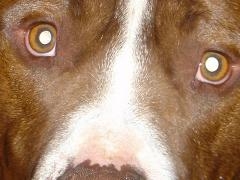Pay Attention

When puppies reach adolescence, food lures temporarily lose effectiveness. The owner and their food lures now have to compete for the dog’s attention with all the more interesting stimuli in the environment. Indeed it is a rude awakening for many owners to discover that their dogs are much more interested in sniffing another dog’s butt or chasing a squirrel than paying attention to them. Most owners resort to upping the olfactory punch (and price) of their food lures. But this seldom works for long. In fact, you may identify forlorn and exasperated owners of adolescent dogs by smell, since they have finally resorted to using dried fish as a lure.
With adolescent dogs we need to temporarily change the type of lure from food to toys. Retrieval toys and tug o’ war toys work the best. Get your dog hooked on fetch or tug and then you may use the toys as lures and rewards to teach him almost anything.
Another approach is to temporarily put food lures aside and to train your dog to pay attention by using all-or-none reward training. Once your dog is paying attention once more, food lure/reward training will work as quickly and as effectively as before.
From simply paying attention to and rewarding your dog for desired behavior as described in the previous exercise, you will find that your dog is much calmer and spends much more time sitting and watching you. This is good. But now we are going to specifically train your dog to pay attention. You may perform this exercise off-leash at home or on-leash on a walk. Rather than feeding your dog from a bowl, weigh out and use his daily allotment of kibble for this and other exercises. Once you have regained your dog’s attention, kibble rewards will be unnecessary and you may feed him how you like. With an attentive dog, your praise will be more than sufficient to further reinforce his attention.
Ignore everything your dog does until he glances at you for an instant. It doesn’t matter how long you have to wait or how short the glance. For the first couple of trials you may have to wait for several minutes but soon you will find your dog will look at you within seconds. As soon as your dog glances at you, say, “Good Dog,” reward him with a piece of kibble and then take one large step (to break his gaze) and wait for him to glance at you again. After a couple of reinforced glances, up the ante in terms of time of attention required for a reward — first one second of attention, then two seconds, three, five, eight, and so on. Count out the time of attention in “good dogs” — “Good dog one. Good dog two. Good dog three, etc.” Once your dog is paying attention for 20 or 30 seconds, you will notice that he is also in a sit-stay.
Now we are going to make it a little more challenging for your dog. After praising and rewarding your dog for looking at you, as you step away, turn your back on your dog to intentionally break his gaze. Give him plenty of time because now he has to work out that staring at your backside is not sufficient, but instead he has to come round in front of you to “find your face.” Praise your dog as soon as he looks up at you and then repeat the sequence.
After a few trials, it’s time to teach your dog to pay attention on cue. Say, “Watch me,” turn away from your dog and praise him as soon as he makes eye contact. Now you will be able to perform this attention exercise in motion by asking your dog to “Watch” while you serpentine backwards away from your dog. Alternatively, ask your dog to watch you while heeling, or during sit-, down- and stand-stays.